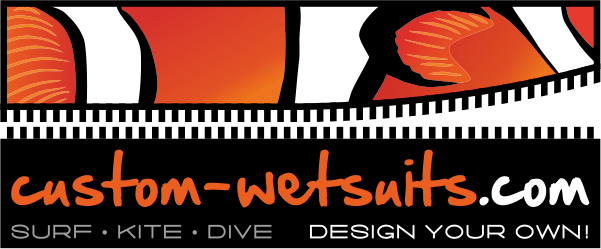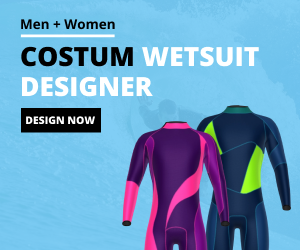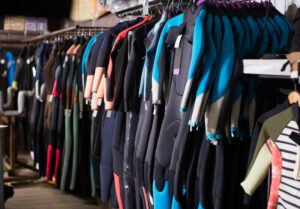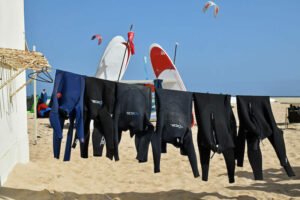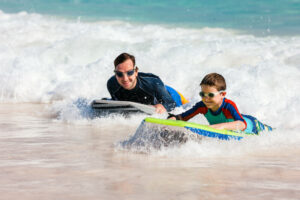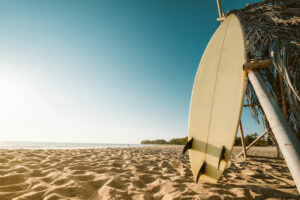Bodyboards come in all kinds of shapes and sizes and have come a long way since their invention by Tom More in the seventies. Back then, when they were still called “Boogie Boards”. Today, bodyboards have advanced and have become a popular type of surfboard, especially among people just starting out with the sport.
Generally speaking, a bodyboard is a surfboard design for riding waves while lying down on the stomach instead of standing. It is therefore important to not only know your own body size, but especially which bodyboard size is the right fit for you to make the most out of your surfing experience. And one thing must be said in advance: the size of your bodyboard depends not only on your height, but also on several other factors that you should definitely consider before buying your bodyboard. In this article, you will learn everything about those factors and which bodyboard size is right for you.
Key Takeaways:
- Which aspects are essential when choosing a bodyboard?
- How do I select the right bodyboard size?
- How can a bodyboard chart help me in picking the ideal bodyboard?
- And which valuable tips can increase my bodyboarding experience?
Bodyboard design – Which aspects are important?
Are you thinking about buying your first bodyboard and can’t wait to take it out to the water to crush some waves? Then look no further, we have all the answers for you needed to make the right choice. Let’s start out with one of the most essential factors: the design.
Bodyboards are typically all made out of foam, which is why they are sometimes also referred to as “sponge boards”. Although the material doesn’t vary, there are still some major differences when it comes to quality and finish.
If you want to get a great experience on the water, you should avoid grabbing the cheapest bodyboard from your supermarket nearby – even though it may be tempting. For the best surfing experience, grab a bodyboard that has a slick bottom that allows for a smooth ride on the water.
Shape is another factor important to consider when selecting a bodyboard, as it can significantly improve or worsen the control of the waves. Make sure to pick a bodyboard that has channels on the base. These channels allow water to flow efficiently, making your bodyboard as aerodynamic as possible. A simple round shape surely won’t do the same magic.
High-quality bodyboards also come with high quality material such as EPS (extruded polystyrene) High Density Pressurized Foam Core. These bodyboards are also equipped with a hard-wearing XPE or IXPE skin that further increase the durability and grip of the board. Cheap bodyboards not only wear off fast, but also have far less grip.
Bodyboard size guide – Choosing the right size
Body height is not the only factor that plays a role when choosing the right bodyboard size. Next to your height, there are two other crucial variables that come into play: your weight and your experience on the water.
Generally speaking, it is recommended that the bodyboard should reach up to your belly button when standing upright. That is a general rule of thumb. The length of your bodyboard, however, also depends on the types of waves you are planning to catch as well as your experience on the water.
For an experience bodyboard surfer, who is able to anticipate wave movements perfectly, a smaller bodyboard is the ideal fit as it increases performance – especially maneuverability and speed. If you are just starting out with bodyboarding, a slightly bigger bodyboard is the one you should go for, as it provides greater buoyancy. Hence, you will be able to jump into the water and catch your first waves with ease.
Bodyboard size chart
To help you find the right bodyboard size, we have created a bodyboard size chart. Remember, this chart acts as an indicator. If you are unsure on whether the bodyboard size recommended – typically measured in inches – is the one for you, don’t hesitate to reach out to us for direct support.
BODYBOARD SIZE CHART IN CENTIMETERS AND KILOGRAMS
| BOARD LENGTH (in) | RIDER HEIGHT (cm) | RIDER WEIGHT (kg) |
| 32″ | 110cm – 145cm | 20kg – 35kg |
| 33″ | 113cm – 148cm | 22kg – 37kg |
| 34″ | 115cm – 150cm | 25kg – 40kg |
| 36″ | 120cm – 151cm | 28kg – 45kg |
| 37″ | 123cm – 153cm | 30kg – 50kg |
| 38″ | 130cm – 155cm | 33kg – 55kg |
| 38.5″ | 135cm – 158cm | 35kg – 58kg |
| 39″ | 138cm – 160cm | 38kg – 60kg |
| 39.5″ | 140cm – 163cm | 40kg – 65kg |
| 40″ | 157cm – 170cm | 42kg – 72kg |
| 41″ | 160cm – 178cm | 55kg – 85kg |
| 42″ | 168cm – 183cm | 70kg – 100kg |
| 42.5″ | 170cm – 189cm | 70kg – 115kg |
| 43″ | 172cm – 192cm | 75kg – 125kg |
| 43.5″ | 175cm – 194cm | 75kg – 130kg |
| 44″ | 175cm – 195cm | 80kg – 135kg |
| 45″ | 185cm – 200cm | 85kg – 140kg |
| 46″ | 190cm – 215cm+ | 90kg – 145kg+ |
BODYBOARD SIZE CHART IN INCHES AND POUNDS
| BOARD LENGTH (in) | RIDER HEIGHT (in) | RIDER WEIGHT (lbs) |
| 32″ | 43 – 57″ | 44 – 77lbs |
| 33″ | 44 – 58″ | 49 – 82lbs |
| 34″ | 45 – 59″ | 55 – 88lbs |
| 36″ | 47 – 59″ | 62 – 99lbs |
| 37″ | 48 – 60″ | 66 – 110lbs |
| 38″ | 51 – 61″ | 73 – 121lbs |
| 38.5″ | 53 – 62″ | 77 – 127lbs |
| 39″ | 54 – 64″ | 84 – 132lbs |
| 39.5″ | 55 – 64″ | 88 – 132lbs |
| 40″ | 62 – 67″ | 93 – 159lbs |
| 41″ | 63 – 70″ | 121 – 187lbs |
| 42″ | 66 – 72″ | 154 – 220lbs |
| 42.5″ | 67 – 75″ | 154 – 254lbs |
| 43″ | 68 – 76″ | 165 – 287lbs |
| 43.5″ | 69 – 77″ | 187 – 298lbs |
| 44″ | 71 – 77″ | 187 – 298lbs |
| 45″ | 73 – 79″ | 198 – 309lbs |
| 46″ | 75 – 85″+ | 198 – 320lbs+ |
Those aspects are important to choose the best bodyboard
Choosing the right bodyboard might be a daunting task when you are just starting out with the sport. There are various aspects one must consider besides color and design. We have identified the most important aspects to help you confidently pick your own bodyboard.
The types of bodyboards
In general, there are two types of bodyboards that can either increase or decrease your performance on the water, depending on your personal style. These types refer to the two types of tails that can be found in bodyboards: crescent tails and bat tails.
Crescent tails are the most common type of tail. They have a curved shape and are a great pick for various types of water and wave conditions, offering a good balance between speed and control. Their user-friendly shape is what makes crescent tails so popular.
Bat tails are not as curved as crescent tails, but rather squared at the end, providing a bigger surface area for the surfer. As bat tails provide surfers with greater maneuverability than crescent tails, these types of bodyboards are usually used in waters with smaller, unpredictable waves.
Material of the bodyboard
Although all bodyboards are made of foam, there are significant differences that you should be aware of. The three most common materials used today are:
- Dow polyethylene foam (PE)
- Polypropylene foam (PP)
- Extruded polystyrene (EPS)
Each of these materials have their own advantages and disadvantages. Dow polyethylene foam (PE) for example is a great all-rounder material that is best used in cold waters. Warmer waters can slightly soften this foam type.
Polypropylene foam (PP) on the other hand is slightly lighter and stiffer than dow polyethylene foam, but can become too stiff for some surfers, especially in colder waters.
Extruded polystyrene (EPS) is typically found in beginner bodyboards, as this foam is cheaper than others and very light. Although these factors generally speak for EPS bodyboards, they lack foam memory and full recoil.
Thickness and width
The thickness of a bodyboard can greatly influence your performance. In recent years, bodyboards have become slimmer and nowadays range somewhere between 45mm and 60mm. Slimmer bodyboards increase the maneuverability in the water.
The width of a bodyboard also affects the surfing experience. Wider bodyboards offer higher buoyancy, but are also more difficult to maneuver. Narrower bodyboards increase performance in the water, but also take time to get used to.
Stringers
As a rule of thumb regarding body weight, heavier surfers should go for boards with stiffer cores and at least on stringer. Stringers are found in modern bodyboards and act like a spine running down the center of the board. They add to the longevity of the bodyboard and provide near-instant recoil and greater projection. Depending on the water and wave condition, you can add or remove stringers to your bodyboard.
A few tips to buy the right surfboard
A few tips can make life a lot easier – you probably know that already. Therefore, we have collected some valuable tips surrounding bodyboards to make your life easier and especially one thing when it comes to bodyboarding: more fun.
Tip Nr. 1 – Don’t choose a bodyboard solely based on color and design:
Carrying a super cool bodyboard under your arm might be fine if the bodyboard also fits you. But don’t fall into the trap and solely select a bodyboard based on appearance rather than function. You might look cool when walking with such a bodyboard, but you will definitely not look cool falling down from it over and over again.
Tip Nr. 2 – Don’t let your friend’s bodyboard influence your decision:
Buying the same products as your friends is only a natural thing to do. But be careful when it comes to bodyboards. There are several factors that affect the type of bodyboard that is best for you. So, instead of looking at your friend’s board, take a look at a bodyboard size chart first.
Tip Nr. 3 – Keep on learning:
Just like with any sport, learning how to bodyboard takes time and practice. So, stay hungry for the next wave and keep asking more experienced bodyboarders for tips and tricks that will help you develop your skills.
Conclusion: Bodyboard size chart – Finding the right board
Bodyboards come in all kids of shapes and sizes, and it is important to know which combination is the right one for you. Instead of choosing a bodyboard solely based on color and design, take a look at the different factors that might influence your decision, such as the type of bodyboard, the material, width, and thickness of the board. Some bodyboards are beginner-friendly, and offer others are best fitted for experienced riders trying to catch more unpredictable waves. In order to make the best out of your bodyboarding experience and to have fun while doing so, make your decision a personal one and you will definitely enjoy the ride!
FAQ – Most asked questions about bodyboard size
When you are just starting out with bodyboarding, we recommend going for a board made of extruded polystyrene (EPS). The material is cheaper than others and gives surfers great buoyancy. When it comes to the tail form you are probably best off with a crescent tail which is very user-friendly and makes it easier for you to catch your first waves.
As a rule of thumb, the bodyboard should reach your belly button when standing upright. To be more specific and make a more informed decision, we recommend taking a look at the bodyboard size chart.
To increase the longevity of your bodyboard, make sure to keep it out of the direct sunlight, as this causes the board to lose its concave. Also remember washing your bodyboard with freshwater after each session to remove the damaging salt. Store your bodyboard without placing anything heavy on top of it, as this can damage the shape of your board. In case your bodyboard does get damaged, get it repaired as quick as possible to prevent long-lasting damage.
Contrary to beginners, more advanced riders often prefer bodyboards made from dow polyethylene foam (PE) or polypropylene foam (PP). These materials are best for carrying out the more advanced maneuvers. Regarding the type of bodyboard, this really boils down to the individual preference of riders. In case you are looking to catch smaller, more unpredictable waves, a bat tail is the one you should go for.
